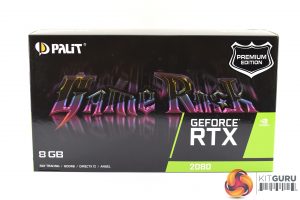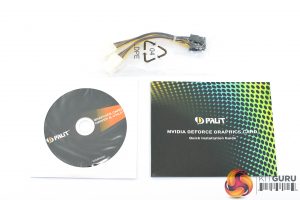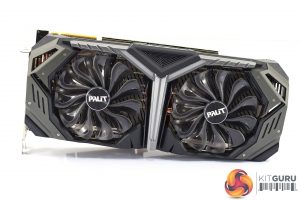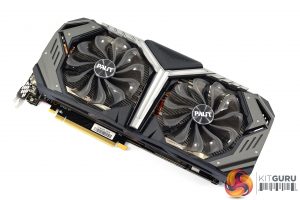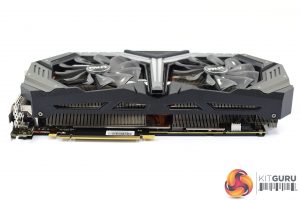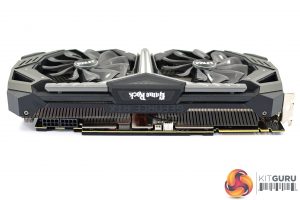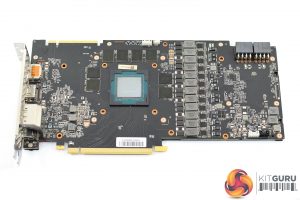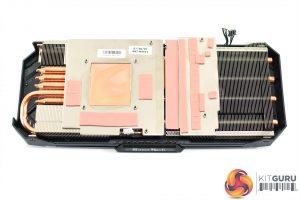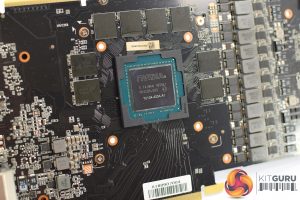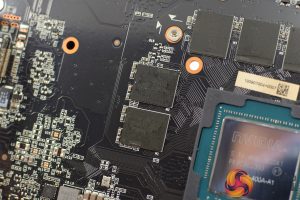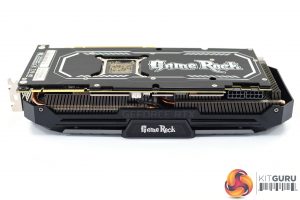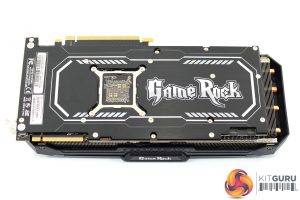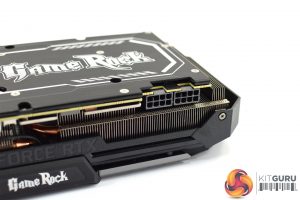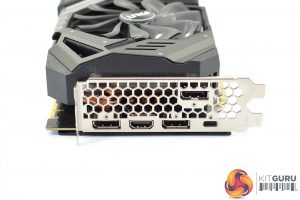The Palit RTX 2080 GameRock Premium ships in a glossy black box, with the multi-colour GameRock branding taking up almost the entire front of the box. There's also a sticker in the top right-hand corner signifying this is the ‘Premium' edition, which has a 60MHz clock speed advantage over the regular GameRock card.
Inside, the included accessories consist of a driver disk, a quick start guide and one 2x 6-pin to 1x 8-pin adapter cable.
Getting a look at the card itself, we can see Palit has opted for a dual-fan configuration, with each fan measuring 95mm in diameter. These are a translucent grey in colour and that matches with the overall look of the shroud – it is a combination of dark grey, black and metallic silver. The grey sections on the far left and right of the shroud are made from metal, but most of it is made from plastic.
Incidentally, the silver Y-shaped section in the middle of the card is home to four LED strips which is where the RGB lighting shines through. I find this a somewhat strange placement for LEDs, as once the card is positioned in a case these will be facing downwards, so unless you have the card mounted vertically you are unlikely to be able to see the light show going on.
Getting a look at either side of the card, we can see more of the plastic shroud as well as some of the aluminium fin stack.
In terms of the GameRock Premium's dimensions, it is not at all small – it measures 292 x 130 x 59.6mm. That thickness of almost 60mm means it is effectively a triple-slot card – Palit says it is officially a ‘2.7' slot card, but you will need three spare slots free in your case.
Getting a look at the PCB only requires the user to remove 8 screws from the back of the card. We can see that Palit has made some fairly significant changes to the PCB design when compared to reference – foremost among these being the move to a 10+2 power phase design, instead of the 8+2 power delivery found on the Founders card. The GameRock Premium also requires 2x 8-pin power connectors as we will see below.
Elsewhere, the 8 GDDR6 memory chips are manufactured by Micron, with the model number 8QA77D9WCW. The GPU die is also labelled TU104-400A – with the ‘A' meaning that this is a binned chip suitable for a factory overclock. Non-A chips have to be sold by Nvidia's partners at reference speeds.
In terms of the cooler, this utilises 5 heatpipes which look like they are each 8mm in diameter. The GPU contacts with a copper core, while there are an additional two coldplates – one for the VRAM chips and one for the VRM. There are also all the necessary thermal pads where we would expect to see them.
On the front side of the card, just to the left of the NVLink connector, there is a BIOS switch which lets you choose between OC mode (setting 1) or standard mode (setting 2). Out of the box, the switch is set to OC mode, with the 1875MHz boost we mentioned. Standard mode drops the clock speed to reference speeds – 1710MHz boost.
The GameRock logo is also visible in the middle of the card's side, though this is only printed in white and is not illuminated by RGB LEDs.
In terms of its backplate, the GameRock Premium's backplate is made of brushed metal, with a cut-out behind the GPU core. Next to that, the ‘GameRock' logo is printed in big, white letters – and the font is very much reminiscent of Guitar Hero. We asked our readers about this on Facebook and we had very mixed responses – it's not for us to say whether you like it or not, but there is no doubt the design is polarising.
As we already mentioned, the card requires 2x 8-pin PCIe power connectors – up from 1x 8-pin and 1x 6-pin of the Founders Edition.
Display outputs are the same as reference, though, with 3x DisplayPort 1.4, 1x HDMI 2.0b and 1x USB-C (VirtualLink) connectors.
 KitGuru KitGuru.net – Tech News | Hardware News | Hardware Reviews | IOS | Mobile | Gaming | Graphics Cards
KitGuru KitGuru.net – Tech News | Hardware News | Hardware Reviews | IOS | Mobile | Gaming | Graphics Cards


